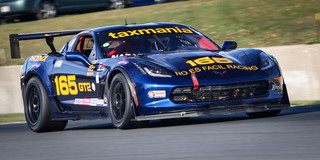
Two months ago, SCCA® hosted its first webinar discussing a proposal that would bring significant changes to the SCCA Road Racing program. The proposal was aimed at improving the experience at the SCCA National Championship Runoffs®, improving the experience and competition at U.S. Majors Tour events (which includes the Hoosier Racing Tire SCCA Super Tour), and supporting class evolution. Based on discussions with the Club Racing Board (CRB), SCCA’s National Board of Directors, and member feedback, a second webinar – held on Aug. 15, 2024 – unveiled the next steps in the proposal.
A detailed recap and video presentation from the proposal made during the June webinar can be viewed here, but the long and short of it is that starting in 2025, the Runoffs would decrease from nine days (which includes three optional test days, three qualifying days, and three race days) to seven (three optional test days, two days of qualifying, and two days of racing). The result is that not all currently eligible Runoffs classes would be invited in the future, and to accomplish this, active class management would be key.
On behalf of the Club Racing Board, SCCA’s National Board of Directors, and SCCA Staff, Vice President of Road Racing Eric Prill led the Aug. 15 webinar that detailed how these changes would take effect.
SCCA Runoffs in 2025
The bulk of the Aug. 15 webinar focused on the classes that will be invited to the 2025 Runoffs.
In 2024, 26 run groups will take place at the Runoffs, with each class having its own run group. At the 2025 Runoffs, there will be 23 classes competing in 18 run groups, with classes being evaluated based on the combination of their current participation levels, growth potential, and diversity of offering for the program. That said, all classes that meet the current GCR 4.0 rule will automatically receive an invitation to the 2025 Runoffs – although that rule will change moving forward.
“With the number of available run groups shrinking by a third going forward, this rule will increase from 4.0 to 5.0 beginning in 2025,” Prill said. “Classes not meeting a minimum of 5.0 may still be invited to the 2026 Runoffs, as has been the case in recent years. This rule is in place to guarantee a spot for the more popular classes.”
Of the 18 run groups, 12 classes will run a single-class race, with no consolidation. Those are:
- B-Spec
- E Production
- Formula Enterprises 2
- Formula Vee
- GT-2
- H Production
- Spec Miata
- Spec MX-5
- Spec Racer Ford Gen3
- Super Touring Lite
- Touring 3
- Touring 4
That leaves six run groups, which will consist of a merged class, three instances of class consolidation, and two combined race groups.
Class Merger
“Prototype 1 and Prototype 2 cars will be adjusted to create a single Prototype class for all races in 2025,” Prill explained. “The performance delta between the current P1 and P2 cars will be closed by adjustments to slow the P1 cars, with many of the restrictions placed on P2 cars when that class was created being removed to increase their performance to a level similar to the former D Sports Racing class.”
For P2, that means the removal of intake restrictors and aerodynamic limitations, as well as additional engine allowances in line with those permitted in P1. For P1, carbon-carbon and carbon-ceramic brake rotors will be prohibited, automotive-based 2.0L, 2.3L, and 2.5L engines will run 1 mm smaller single inlet restrictors and automotive-based 1.6L Formula Atlantic-based engines will run 1 mm smaller chokes.
The new Prototype class will have a National Championship race at the 2025 Runoffs in a combined race with Formula Atlantic.
Class Consolidations
GT-Lite and F Production
GT-Lite will not be a Runoffs class in 2025, but GT-Lite cars will be eligible to compete in F Production with a new “GTL” addition to the FP spec lines. These classes already run similar lap times, but in a slightly different fashion.
To be eligible to compete in F Production, current GT-L cars will remove the rear wing and change the sequential transmission weight penalty from 1.25% to 2.5%.
“These adjustments are designed to balance the performance of the cars both in corners and on the straightaways,” said Prill.
Moving forward, GT-Lite will become a Regional-only class beginning in January 2025, with the F Production spec line becoming available at the same time.
Super Touring Under and GT-3
In 2025, STU and GT-3 will continue to run as two separate classes, with STU absorbing GT-3 in 2026.
“These classes have qualified together at the Runoffs recently and have similar performance characteristics that can be balanced, not unlike what was done with GT-2 and STO years ago,” Prill added. “Adjustments will be made to both classes in 2025 to evaluate parity, with both classes crowning Champions, but running together.”
Beginning in 2025, STU will see weight reductions for all vehicles of 4% after all other modifiers. Also, the 9-inch wheel minimum weight will reduce to 2,850 lbs, and GT-3 legal TCR cars will be included with a maximum DOT-approved tire width of 245 mm.
Meanwhile, all GT-3 cars will move to DOT-approved race tires with a maximum width of 245 mm, and cars running 15x7-inch wheels limited to 225 mm maximum width may reduce their weight by 25 lbs. All non-TCR cars will add 150 lbs after all other modifiers.
With 2025 being a transition year for GT-3, there will be two classes during the season: GT-3, which will run at U.S. Majors Tour events and the Runoffs with balance of performance adjustments in preparation for the move to STU in 2026, and Regional GT-3 (R-GT3) based on the 2024 rules that can participate in SCCA Regional-sanctioned events. The Regional GT-3 class will continue into 2026.
Touring 2 and American Sedan
Touring 2 and American Sedan will continue to crown separate race winners through 2025, but the classes will race together, with the intention of having American Sedan cars be T2-eligible in 2026 after evaluating the following adjustments to AS-spec cars:
- Maximum tire size up to 315 mm for cars below 3,500 lbs; 335 mm over 3,500 lbs
- Open transmission ratios
- Expand allowance of composite hoods to include front fenders (per Production category rules)
- Glass may be replaced with Lexan
- Rear fenders may be flared to accommodate wider tires (per Production category rules)
- Weight reduction of 3% for each spec line, consideration for restrictor relief for vehicles that cannot achieve the weight reduction
Like GT-3, there will be two American Sedan classes in 2025, one for Regional competition based on the 2024 regulations and one for Majors and Runoffs competition with the adjustments in preparation for joining Touring 2. The Regional American Sedan class will continue in 2026.
Combined Race Groups
The following will be combined into a race group, but compete for separate Championships. These classes are not part of a consolidation plan at this time:
- Formula F and Formula Continental
- GT-1 and Touring 1
All multi-class races at the Runoffs will have a split-start procedure.
Not Invited to the 2025 Runoffs
The following 2024 classes will not be a part of the 2025 National Championship Runoffs:
- GT-Lite: Cars will be eligible for F Production with modifications
- Prototype 1 and Prototype 2: Will be consolidated into a class named “Prototype”
- Formula 600: Participation has declined, and the cars are not believed to be compatible with another class
2025 Runoffs: The Bottom Line
The class breakdown for the 18 Runoffs race groups for 2025 will be (listed alphabetically):
- B-Spec
- E Production
- Formula Atlantic and Prototype (new class including P1 & P2 cars)
- Formula Enterprises 2
- Formula F and Formula Continental
- F Production (including spec line for GT-L cars)
- Formula Vee
- GT-1 and Touring 1
- GT-2
- H Production
- Spec Miata
- Spec MX-5
- Spec Racer Ford Gen3
- Super Touring Lite
- Super Touring Under and GT-3
- Touring 2 and American Sedan
- Touring 3
- Touring 4
Next Steps
A third webinar, covering the U.S. Majors Tour and Hoosier Super Tour, is planned to occur before the 2024 Runoffs.
Prill concluded the webinar by thanking those in the Club Racing Board and Board of Directors who have volunteered their time to develop the forward-looking road racing plan.
“These fellow members have donated their time because of their love for this sport and this Club,” he said. “What they are doing is difficult, and often uncomfortable. As of this month, we have roughly 52,000 members, which means there are about 52,000 ideas of how the organization should operate. We will again hear feedback that ranges from ‘spot on’ to ‘you’re out of your minds.’ And the Club, as always, welcomes thoughtful feedback and dialogue. The formal way to submit feedback is through www.crbscca.com.
A detailed summary document of these changes is now available here. Also, the changes presented in the webinar will appear in an upcoming Fastrack.
The entire webinar can be viewed on-demand below:
Photo by Jeff Loewe










